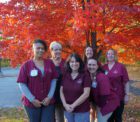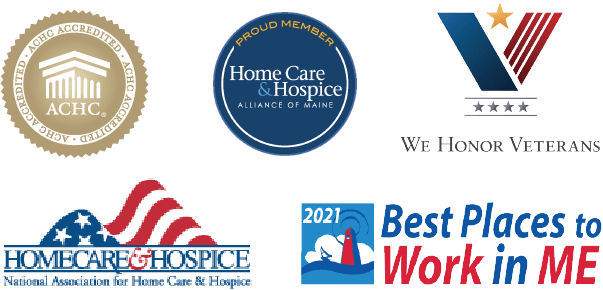Androscoggin Home Healthcare + Hospice was selected by the National Association for Homecare & Hospice (NAHC) to share with them a unique story of six hospice mother and daughter nurses all who work for Androscoggin. Director of Communications from the NAHC, Tom Threlkeld visited with them in October.
An old woman in hospice has a last request – she wants to see the shore one more time. Her hospice nurse makes arrangements for it to happen, but on the day of the visit, the patient is too weak to make the trip. Instead, the patient’s hospice nurse and her team videotape scenes at the beach in Maine and return to the woman’s house. There, they project the videotape of the beach on a screen, adding wave sounds and sand for the woman to touch as she watches the video. Afterwards, she speaks softly about how much it meant to her that she got to see the shore, if not in person, one more time. And that people who are not related to her by blood or marriage would go to such trouble to care for her last wish.
Not long after, the woman passes away, her final wish realized as much as possible.
That true story was told to me by a hospice nurse in Maine. Something I quickly learned during the time I spent with six incredibly dedicated and hard-working hospice nurses in Maine, is that doing their jobs well often means doing things that are never taught in nursing school.
But first, let’s back up to the beginning.
When NAHC learned that one of our members, Androscoggin Home Healthcare + Hospice, had three mother-daughter hospice nurses working for them in Maine, we knew there was a story (or two) to be written. How in the world did not one, not two, but three mother-daughter pairs come to work for the same company – and all as hospice nurses? NAHC Report traveled to Lewiston, Maine to find out.
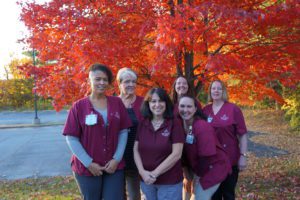
Their names are Tammy Bean and her daughter Nicole Martin, Angela Bolden and her daughter Shanna Teague, and Karen Madore and her daughter Karri Gallant. Their stories about coming to nursing and hospice nursing, in particular, are different, but again and again they gave me very similar answers to some important questions, allowing me to understand why hospice nurse is a unique job in American health care, and it requires unusual persons to do the job well.
I spoke to all six nurses separately, so each would get plenty of time to speak and so their answers would not influence each other.
Oddly enough, none of the daughters felt any obligation to follow in their mother’s work, nor did they say their mother’s put undue pressure on them to become hospice nurses. But they had similar answers to the same questions, confirming my suspicions that a good hospice nurse is not like anyone else.
What does it take to be a hospice nurse?
The job of a hospice nurse is make their patients as comfortable as possible in the last months of their lives, but how they accomplish that is the real story. It turns out, monitoring a patient’s medical condition and administering medication is just the very beginning.
A good hospice nurse should be “a good multi-tasker,” says Karri Gallant. “And willing to talk about difficult issues.”
“A hospice nurse should be caring, compassionate, and able to work autonomously,” Nicole Martin, RN told me. Her mother, Tammy Bean, who has been a nurse for 23 years, tells me a hospice nurse must be “compassionate and empathetic.” Shanna Teague cites “empathy” as the necessary quality, while her mother Angela Bolden returns to “compassionate.” Karen Madore, the first LPN to become part of the hospice program at Androscoggin, agrees, telling me a “compassionate” person is required to be a hospice nurse.
That seems logical, even obvious, but what does it mean in practice? Well, it means doing things that are not found in textbooks or taught in school. It means doing things like videotaping the Maine shoreline so a woman near death can see and hear her beloved beaches one more time. This is not a thing that can be taught. One either cares enough, possesses the empathy, compassion, and creativity to do such a thing or one does not.
What does it take to be a hospice nurse? A good hospice nurse does everything her years of schooling tells her to do – and then she gets on with the rest of the job. Which, it turns out, is most of the job. For a hospice nurse, there is no such thing as going the extra mile for a patient because the entire job is about going the extra mile.
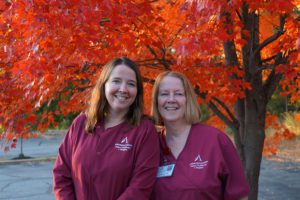
Karri Gallant and Karen Madore
Making the end a success
An elderly hospice patient is in bed in his living room, with his family around him. They are holding hands around his bed and singing hymns they’ve all sung many times before. These are songs of comfort and joy and they bring smiles to the faces of the family as they sing. The patient, too weak to leave his bed, sings weakly along with them, gazing up at his loved ones, the people who have been there for most of his life and the people who mean more to him than anything else in this world. This is how he wanted to spend the last days and hours of his life and his hospice nurse made sure it would happen. He is in no pain and his face is a map of contentment and gratitude. He seems ready.
This story, also told to me by one of the six hospice nurses I interviewed at Androscoggin, is an example of what it means to do things the right way.
The job of a hospice nurse is like none other in health care. No hospital nurse, no matter how dedicated, would consider it part of her duty to simulate a day at the beach for a patient in her care. And arranging for a family gathering to sing hymns would be difficult in a cramped hospital room, filled with gadgets and tubes, with hospital workers constantly moving in and out. The nurse’s job would be to get the patient as healthy as possible as quickly as possible to prepare him or her for discharge back home.
But when your patient is not going to improve, when rehabilitation or a cure is not an option, what constitutes success? What is a successful hospice patient?
When she first takes on a new patient, Shanna speaks with the patient and family and wants to know what their goals are. “I’m here to talk about how you live until you die,” says Shanna. “It’s about their life and how they want to live the rest of it.” Shanna considers “sitting and listening” to be one of the most important parts of her job.
Shanna’s mother Angela, who has been a nurse for over 45 years, echoes those thoughts. “Hospice is not about death. It’s about how you live every day until you die.”
“It’s a completely different mindset,” says Karri Gallant. “It’s all about comfort and quality of life.” For Karri, success means “their passing was peaceful.” Karri goes on to emphasize that “we have a quality of life program at Androscoggin and it’s about helping the patient and family figure out what they want and then making it happen.”
“Let’s make it the way you want to go, says Karen Madore. “We’ll do this the right way.”
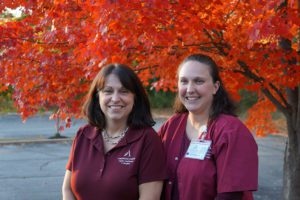
Tammy Bean and Nicole Martin
Go, Team
Hospice nurse Nicole Martin oversees a sizable staff at Androscoggin, and you can tell from her knowledge and enthusiasm for the job why she has been entrusted with her authority. Nicole was a home health aide for hospice before becoming a hospice nurse, something she has been for the last seven years. To Nicole, hospice is a team effort.
“This team is amazing,” she says, referring to the home care aides, social workers, and chaplains who are directed by the nurse in the care of a patient. “We have a holistic approach that is all about meeting all the needs of the patient. Many of those needs we (nurses) can meet, but some we can’t and that’s what the whole team is about.”
Nicole’s mother Tammy agrees. “We have a whole team to take care of every patient. We are making them comfortable for their journey.” Shanna and her mother Angela echo the notion of a team effort, emphasizing that no one person can do the job alone. The help they receive from their colleagues at Androscoggin, they are quick to point out, is critical.
Home care aides handle many of the activities of daily living and assist the nurse. Social workers assist the patient and family in identifying and accessing available social services, as well as generally advocating for the wishes of the patient and assessing his or her psychosocial needs. Pastors or chaplains provide emotional and spiritual counseling to the patient and family and assist with bereavement issues.
I was deeply impressed by each nurse’s appreciation for their team members and Androscoggin. I spoke to each nurse separately and never asked any of them to talk about their employer. They did so anyway.
“I’m so happy she (Shanna) followed me into hospice and to Androscoggin,” says Angela of her daughter Shanna. “This is the right place for us.”
“I consider this agency my home,” Nicole told me.
“Androscoggin is family,” says Nicole’s mother Tammy. In their case, of course, that’s true in the most literal sense, but the team approach these nurses have forged at Androscoggin is clearly a key reason for their success.
Focus on the family
While virtually all health care workers are focused on the needs of the patient, hospice nurses and their teams often focus just as much attention on the family of the patient. In fact, “at least 90 percent of the job is dealing with the patient’s family,” says Nicole.
Part of the reason is that when hospice begins, patients are usually ready for it. Some have been ready for a while. Families, on the other hand, are often not ready at all. Many of them see hospice as “giving up” and believe the health care system is just turning its back on their loved one. In fact, the health care system is about to give their loved one the most caring, patient-centered, and personal attention they will likely ever receive.
“Teaching families to physician their loved one,” is an important part of the job, according to Nicole. “You have to teach them what to look for, what they may see or not see. Teaching them what to expect.”
In addition, since so many of her hospice patients have dementia, communicating with the family is critical, says Nicole. “You have to get to know the family. How can you provide good care if you don’t get to know them.”
“They become like extended family,” says Shanna of her patients and their loved ones. Her mother Angela says she loves “the relationships you develop with people. It is an honor to be able to take care of their loved ones.”
The attention paid to the family pays off, the nurses told me, because those who were often the most upset about seeing their loved one in hospice are often the most grateful for the service. “They appreciate that their loved one got to die on their own terms. When it happened, they felt prepared,” says Angela.
“Having that relationship, that rapport” with the family “is so important,” says Nicole.
Karri says the families often thank her after their loved one has died because it was more peaceful and less painless than they’d feared when hospice began. “Families are so glad they made this decision” (to go with hospice), says Karri.
Inevitably, it’s an emotional time for the family and the nurse. “I try not to let the family see me cry,” says Nicole, “but it happens.” Her mother Tammy says “I still cry with patients. It happens… It can be gut-wrenching for some, but my job is to make them comfortable – the patient and the family.”
“Everybody goes with dignity,” says Karen. “Everyone is treated with respect, like they deserve.” For her part, Karen feels grateful to be able to take care of patients at the end. “I’m grateful that I got to be part of their journey,” she says. “It’s an honor.”

Shanna Teague and Angela Bolden
Being there
Eventually, every hospice nurse will be with a patient when death occurs. It’s a powerful, personal moment and each nurse spoke of it reverently, without fear.
Karri told me she wants to be there when the patient passes away and has been on hand when it happened three times. “It’s the most peaceful thing.”
“It’s better if you can attend the death,” says Karri’s mother Karen. “It’s an incredible thing. And to be there for the patient and the family is so important.”
“It’s a little bittersweet,” says Nicole, “because we’ve accomplished what we set out to do, which is have a peaceful death.”
“Dying is part of living,” says Angela. “We shouldn’t fear it. We should make it as best we possibly can.”
“I wish everyone could have those moments,” says Angela’s daughter Shanna.
“I’m there at such a tender moment,” says Tammy. She pauses and looks me straight in the eye. “I don’t fear death.”
Why hospice?
The nurses I spoke to are first-rate professionals and could work in any line of nursing, but they’ve chosen hospice. Why?
“Hospice is kind of my niche,” says Nicole, who learned from her mother Tammy that interacting with patients and their families in their own homes could be very rewarding. “My mother has always been very honest with me about being a hospice nurse and about death and dying. I felt prepared.”
“If I can be half the nurse she is some day, that would be an honor,” Nicole says of her mother. “I’m the proudest mom,” Tammy says of her daughter Nicole.
Nicole cites some of the challenges of being a hospice nurse, particularly new and growing regulation that can make her job more difficult, she still wouldn’t be anywhere else. “I think this job has made me a better person.”
“I get to use my creativity,” says Tammy, who says finding ways to make sure patients are comfortable and families are happy with the care and on board with the decision, keeps her sharp.
Hospice “speaks to my soul,” says Shanna. “It’s patient-centered, patient-focused work… It’s a good job to have.”
“The difference I make in people’s life in that time I’m with them makes the job worthwhile,” says Karen. “The peace, the comfort are what I get out of hospice.”
Angela, who cites a speech by hospice pioneer Elisabeth Kubler-Ross, as inspiring her to go into this line of nursing, left hospice for some time, but knew she would come back to it. She’s very happy at Androscoggin and says “I’ll keep doing hospice nursing until I retire.”
Summing up
It would not be possible to properly thank the six nurses who gave generously of their time to speak to me. I hope their words will do for others what they did for me – demystify something we are all too often afraid to discuss. The team at Androscoggin is justly proud of the work they do and I am honored that they let me see just a bit of it.
Like perhaps most people, I used to view hospice with a certain amount of dread, but no longer. I thought I knew what hospice was about, but I had it entirely backward. I went to Maine thinking I would learn something about the most mysterious part of our human existence, death. Instead, I learned about life – the value of living it well right up to the end. And who to turn to if we need some help with that.
The most important lesson I learned about hospice is this: Hospice is not about death, it is about living the rest of our lives the way we want to live and with the people we want around us.
Isn’t that the way we should live our lives all the time anyway?

